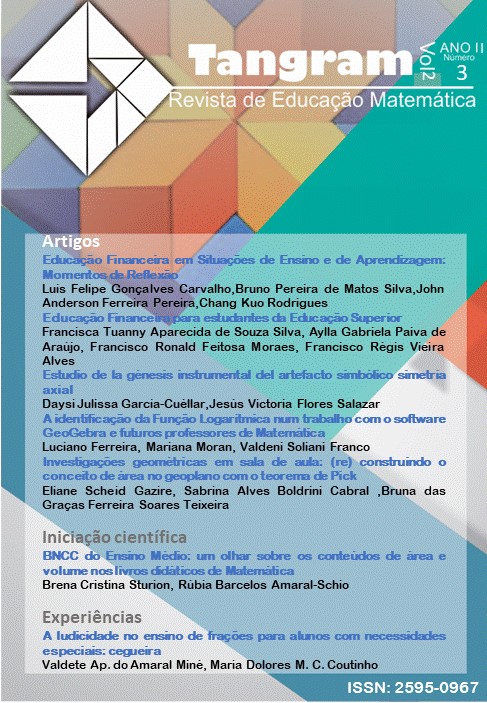BNCC do Ensino Médio: um olhar sobre os conteúdos de área e volume nos livros didáticos de Matemática
DOI:
https://doi.org/10.30612/tangram.v2i3.10441Keywords:
Base Nacional Comum Curricular. Figuras planas. Corpos redondos. Poliedros. MTSK.Abstract
O presente trabalho é fruto de uma pesquisa qualitativa realizada a partir da análise de três coleções de livros didáticos de Matemática de Ensino Médio, aprovados pelo PNLD 2018. O foco de estudo esteve nos conteúdos de área e volume, e para a análise foi considerado como referencial teórico o conhecimento especializado do professor de Matemática. Para discussão no evento, nosso objetivo é trazer os resultados que tangem à apreciação desses conceitos à luz da Base Nacional Comum Curricular (BNCC). Após uma análise documental pudemos perceber que, ainda que os livros tenham sido escritos antes da publicação da BNCC, a maior parte das habilidades sugeridas por esse documento é contemplada no desenvolvimento desses conteúdos.
Downloads
References
Alves-Mazzotti, A.J. (2001). O método nas Ciências Sociais. In: ALVES-MAZZOTTI, A.J.; GEWANDSZNAJDER, F. O método nas Ciências Naturais e Sociais: Pesquisa Quantitativa e Qualitativa. São Paulo: Editora Pioneira. p.107-188.
Ball, D.L.; Thames, M.H.; Phelps, G. (2008). Content knowledge for teaching: What makes it special?. Journal of teacher education. 59 (5). p.389–407.
Bogdan, R. C.; Biklen, S. K. (1994). Investigação qualitativa em educação. Porto: Porto Editora.
Brasil, Ministério da Educação. (2017). Base Nacional Comum Curricular. http://basenacionalcomum.mec.gov.br/wp-content/uploads/2018/06/BNCC_EnsinoMedio_embaixa_site_110518.pdf.
Denzin, N.K.; Lincoln, Y.S. (2000). The discipline and practice of qualitative research, In: Denzin, N.; Lincoln, Y.S. Handbook of qualitative research. Second edition. Londres: Sage publications.
Flores-Medrano, E., D. Escudero-Ávila, M. Montes, A. Aguilar, e J. Carrillo. (2014). Nuestra modelación del conocimiento especializado del profesor de matemáticas, el MTSK. Un marco teórico para el conocimiento especializado del profesor de matemáticas, p.70–92.
Iezzi, G.; Dolce, O.; Degenszajn, D.; Périgo, R.; Almeida, N. (2017). Matemática: Ciência e Aplicações. 9o ed. Vol. 1. São Paulo: Saraiva.
Leonardo, F. (2016). Conexões com a Matemática. 2o ed. Vol. 2. São Paulo: Moderna.
Lincoln, I.S.; Guba, E.G. (1985). Naturalistic Inquiry. London: Sage publications.
Shulman, L.S. (1986). Those who understand: Knowledge growth in teaching. Educational researcher. 15 (2), p.4–14.
Souza, J. Garcia, J. (2016). Contato Matemática. 1o ed. Vol. 2. São Paulo: FTD.
Vidich, A.J.; Lyman, S.M. (2000). Qualitative Methods: Their History in Sociology and Anthropology. In: Denzin, N.K.; Lincoln, I.S. (Org.). Handbook of Qualitative Research. 2.ed. London: Sage publications.
Downloads
Published
How to Cite
Issue
Section
License
Authors must accept the publication rules when submitting the journal, as well as agree to the following terms:
(a) The Editorial Board reserves the right to make changes to the Portuguese language in the originals to maintain the cultured standard of the language, while respecting the style of the authors.
(b) Authors retain the copyright and grant the journal the right to first publication, with the work simultaneously licensed under the Attribution-NonCommercial-ShareAlike 3.0 Brazil (CC BY-NC-SA 3.0 BR) that allows: Share - copy and redistribute the material in any medium or format and Adapt - remix, transform, and create from the material. CC BY-NC-SA 3.0 BR considers the following terms:
- Attribution - You must give the appropriate credit, provide a link to the license and indicate whether changes have been made. You must do so under any reasonable circumstances, but in no way that would suggest that the licensor supports you or your use.
- NonCommercial - You may not use the material for commercial purposes.
- Sharing - If you remix, transform, or create from material, you must distribute your contributions under the same license as the original.
- No additional restrictions - You may not apply legal terms or technological measures that legally restrict others from doing anything that the license permits.
(c) After publication, authors are allowed and encouraged to publish and distribute their work online - in institutional repositories, personal page, social network or other scientific dissemination sites, as long as the publication is not for commercial purposes.






